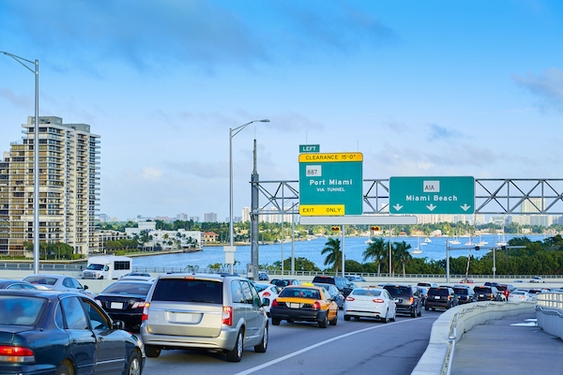For now, traveling isn’t possible due to the COVID-19 pandemic. That being said, the upcoming Real ID rules will have a huge impact on domestic travel in the U.S., so you don’t want to be caught unprepared once it’s safe to fly again. The Real ID rules are 15 years in the making and have undergone several phases of implementation between different states, which has created some confusion — to say the least. Read on for our comprehensive guide to everything you need to know about Real ID rules.
WHAT IS A REAL ID?
A Real ID is not an entirely new form of identification, rather, it’s a driver’s license or state identification card that requires additional scrutiny and verification to obtain. Otherwise, a Real ID-compliant version does not disclose any additional information other than what a traditional driver’s license already provides.
WHY ARE REAL IDS REQUIRED?
This change in regulation is derived from the Real ID Act, which was passed in 2005 to increase domestic air travel security in response to the 9/11 terrorist attacks. The anti-terrorism legislation set national standards for states in how they issue identification, such as driver’s licenses and identification cards. These measures add extra steps to verify an applicant’s identity, such as in-person appointments and providing various forms of identification. Additionally, the standards address counterfeiting by upgrading the technology used by states to produce the physical driver’s license or identification card.
To determine if your driver’s license or identification card is in fact a Real ID, check the upper right-hand corner of the card. If it contains a gold or black star, gold or black star cutout, or (in the case of California) a star cutout in a gold grizzly bear, then it is Real ID-compliant and you are all set. On the other hand, if you see either “Not for Federal Identification” or “Federal Limits Apply,” it is not a compliant ID. A final caveat: Hawaii, Ohio, and Utah residents missing a star should double-check their status with their respective state government, as compliant identification without a star label has been issued by these states previously.
WHAT IS A REAL ID USED FOR?
Once the Real ID law goes into effect in 2021, a Real ID will allow travelers to pass through TSA security to board a domestic flight. A Real ID also carries non-travel implications, such as access to military bases, Department of Homeland Security, nuclear power plants, and some additional federal sites. It’s also important to note that the rule change does not apply to driving, voting, applying for or receiving federal benefits, and accessing federal sites like National Parks.
WHY HAS IT TAKEN SO LONG TO IMPLEMENT REAL IDS?
Although Congress passed the law in 2005 and it was strongly supported by the Bush administration, many state governments across the country resisted the legislation to varying degrees. Utah’s state legislature passed a resolution in 2007 that opposed the Real ID Act by unanimous vote. Twenty-four other states have followed suit in passing legislation against the Real ID Rules. The Real ID Act also received opposition from a diverse coalition ranging from human rights organizations concerned about the impact on immigrants to libertarian groups against federal government intervening in state-level affairs. President Obama vocally opposed the Real ID Act and did not push for its implementation during his presidency.
ALMOST EVERY US STATE AND TERRITORY IS REAL ID-COMPLIANT
As of publishing, four remaining states and territories that have yet to achieve Real ID compliance are American Samoa, Northern Mariana Islands, Oklahoma, and Oregon. Both Pacific territories are currently under review, meaning that they will be permitted to start issuing Real IDs as soon as they are deemed compliant. Oklahoma and Oregon both received an extension. Oklahoma plans to begin issuing Real ID-compliant driver’s licenses and identification cards on April 30, 2020, whereas Oregon may begin on July 6th, 2020. Note that the COVID-10 pandemic may impact these dates.
There have been significant disparities in implementation between states. For instance, Georgia has been issuing compliant identification since 2012, while states like California and New Jersey only began doing so in 2018 and early 2020, respectively. As of January 2017, only 26 states were compliant, meaning that 22 states have only just become Real ID compliant in the past three years. However, that does not mean that every license or ID card issued since that date is actually compliant. From the 48 compliant states, 95 million Real ID-compliant driver’s license and ID cards have been issued, which accounts for just 34% of license holders.
THERE ARE SEVERAL ALTERNATIVES AND EXEMPTIONS TO HAVING A REAL ID
While there are certainly millions of Americans who will need to update their driver’s license to fly domestically in the fall of 2021, many travelers already possess forms of ID that satisfy the rule change. For starters, a U.S. passport or passport card will suffice, though some travelers may prefer to carry a sleeker, less expensive form of ID. Residents in the Canadian-border states of Michigan, Minnesota, New York, Vermont, and Washington state will be glad to know that a state-issued Enhanced Driver’s License is approved as well. An Enhanced License similarly requires an in-person application, but has the added perk of allowing land and sea border crossings to Canada, Mexico, and some Caribbean nations. Other compliant forms of ID include a foreign government-issued passport, permanent resident card, federally-recognized tribal photo ID, Canadian provincial driver’s license, and traveler cards like Global Entry and NEXUS. The most notable exception to the rule change is TSA Pre-Check, which is not considered Real ID-compliant.
A handful of exemptions for having a Real ID when flying domestically exist as well. TSA does not require that Children under 18 show identification for domestic travel. Travelers who forget their valid identification at home or lost it during their travels aren’t totally out of luck either. Under these circumstances, travelers must agree to a verification process with a TSA officer. This entails collecting information to confirm one’s identity, such as name, address, and date of birth. Cooperating and passing this process may involve additional screening by individual pat down and inspecting carry-on baggage.
THE DEADLINE TO OBTAIN A REAL ID WAS EXTENDED ANOTHER YEAR
On March 23, the federal government postponed the Real ID deadline from October 1st, 2020 to October 1st, 2021 due to the COVID-19 pandemic. DMV offices are closed around the country except for commercial licensing in some cases, and since the application requires in-person appointments, Americans are unable to obtain a Real ID for the time being. The extension will also discourage a rush on DMV offices upon reopening while social distancing is still an essential precaution. Given the unprecedented circumstances, it’s advisable to keep an eye out for additional changes and updates.
In the meantime, there is no harm in preparing the necessary documentation to submit online and get a jump on the application process. This documentation includes items like social security cards and driver’s licenses that can prove an applicant’s identity and residency. While this online option is certainly helpful in streamlining the process, you’ll still have to visit the DMV for an in-person meeting.
WHAT DOCUMENTS DO YOU NEED TO OBTAIN A REAL ID?
Applicants have several options at their disposal for obtaining a Real ID. An existing form of ID that includes your full legal name and birthday is required, such as a driver’s license or passport. If you do not have a valid license or ID card, you will likely need to verify your age via birth certificate. The remaining requirements that need to be satisfied are proof of residency and social security status. Residency can be established with a standard state-issued license, permit, or non-driver ID in combination with another document that verifies your address, such as a bank statement, utility bill, credit card bill, high school photo ID and report card, or pay stub. You can verify your social security status with either a social security card or a tax form, such as a W-2 or state income tax or earning statement that includes your full social security number. If you’ve changed your name from what is on your birth certificate, you may need to submit a marriage certificate or other documentation granting the name change.
HOW MUCH DOES A REAL ID COST?
The cost varies by state, but is cheaper than a passport book across the board. New York does not charge an additional fee for a Real ID-compliant driver’s license, while Virginia and California tack on additional fees of $10 and $35, respectively. Residents in states like Pennsylvania, which charges $60 for a new ID, may want to opt for a comparably priced passport card ($65), since it grants a wider range of travel accessibility. Be sure to check with your own state’s fees and pay attention for varied rates based on license expiration date and age.
———
At Oyster.com
———
©2020 Oyster.com
Distributed by Tribune Content Agency, LLC.












